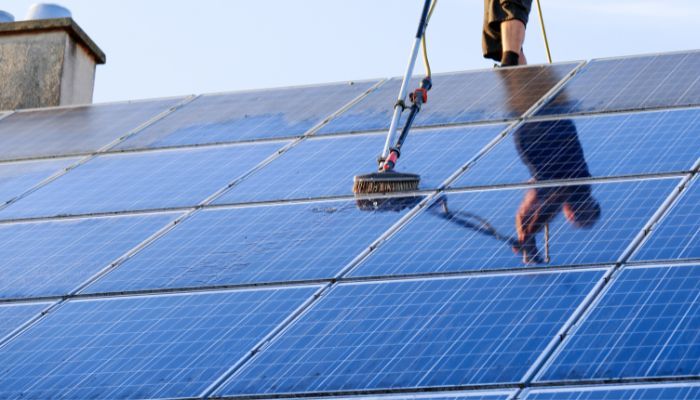Stay Toasty: Ensuring Your Dryer’s Best Performance this Winter

As wintertime fast approaches, an important home chore to consider is the maintenance of your dryer. Regularly checking your dryer to diagnose any issues, and taking care to ensure that it is functioning properly, can be essential in maintaining the efficiency and safety of your dryer during the colder months. This article will explain the importance of dryer maintenance in winter, the steps to optimize your dryer’s efficiency, how to address common winter dryer issues, and important safety precautions for preventing fires in cold months.
The Importance of Dryer Maintenance in Winter
Dryer maintenance during the winter is an important practice in order to maintain the appliance in good working order. During the cold winter months, lint buildup in dryers is more frequent, due to static electricity and garments that shed greater amounts of lint. This lint can be a potential fire hazard, so keeping up with dryer maintenance is important. Ut is important to keep the dryer vent clean, free from unwanted debris, as this can also be a fire hazard.
In addition, if the lint trap of the dryer is clogged, it restricts airflow, causing problems with the dryer’s performance. Therefore, regularly cleaning the lint trap is important. Moreover, cleaning the exterior of the dryer can also prove beneficial. Over time, a buildup of grime, dirt, and dust can form on the appliance’s exterior. This grime can cause problems with the appliance’s performance which may affect the efficiency of the dryer. Similarly, a buildup of dirt and dust can reduce the quality of clothing as lint can be embedded in the fabric while running.
Checking that the dryer’s vent isn’t blocked can prevent mistakes in the winter. Such blocked vents can cause an increase of heat and humidity, followed by a decrease in temperature which can lead to a freezing of the machine’s internal parts. Also, checking the air flows in the vent and making sure it is not too restricted, helps to maintain the dryer’s efficiency. As a result, regularly checking the dryer’s vent and cleaning the lint trap and exterior can ensure the appliance runs smoothly during the winter months.
In contrast to other household appliances, dryers need particular attention during the winter months. Properly checking and maintaining the appliance helps to prevent any problems and fire hazards that may arise due to the cold weather conditions. It is important to take the time to clean the dryer and perform regular checkups to ensure it runs properly during the winter.
Steps to Optimize Your Dryer’s Efficiency
One of the best ways to optimize the efficiency of your dryer is to make sure that the lint screen is always clean. This helps to prevent the dryer from having to work excessively hard, as a blocked lint screen can decrease the efficiency of the dryer. Additionally, using a shorter drying cycle will help the dryer to consume less energy. Reducing the temperature of the cycle that you are using can also help to increase efficiency.
On the other hand, taking the clothing out immediately after the drying cycle has completed can help to improve efficiency. Additionally, regular maintenance, such as cleaning the dryer vents and ducts, is another key factor in ensuring that the dryer remains energy efficient. Furthermore, it is important to avoid overloading the dryer as this can reduce the effectiveness of the machine and stall the air flow. Similarly, removing large items such as bedding items and thick towels one at a time can help the dryer perform better.
Consequently, leaving a few inches of space between the wall and the back of the dryer can help the air circulate better and make the machine work more efficiently. In addition, keeping the outside of the dryer access panel clear of any obstructions will help to keep the vents and ducts clear, thus ensuring that air can move freely and efficiently though the dryer. As a result, this will mean that the dryer will end up using less energy. For instance, ensuring that any of hoses or clamps that are connected to the dryer are secure can also help the dryer to maintain its efficiency.
Addressing Common Winter Dryer Issues
Winter can be hard on a clothes dryer, with the cold temperatures and added humidity causing issues with proper machine functioning. However, there are several common problems that can arise during the winter months and several steps to take to address these issues.
Firstly, one of the most common issues with winter dryers is that they must work harder due to the chilly air and insufficient warmth. To combat this, it is beneficial to make sure that the lint trap is regularly cleaned in order to allow the dryer to adequately circulate air and dry clothes efficiently. Additionally, homeowners should make sure that the dryer is not obstructed, allowing a free air flow to pass freely through the machine.
In addition to these steps, it is important to check the vent system to ensure that it is properly installed. During winter months, the vents can become clogged with debris and ice, causing a blockage in the exhaust and slowing the machine functioning. Furthermore, the vent should be checked for leaks, as it can allow cold air to enter the dryer and compromise its performance.
The drum roller should be regularly inspected to ensure that it is functioning correctly, as a worn-down or damaged belt will interfere with the dryer’s spinning and heating capabilities. Similarly, the door seal should be inspected for any dirt or dust buildup that may prevent the dryer from forming an air-tight seal.
Lastly, it is beneficial to regularly check the thermal fuse of the dryer. This device is designed to shut off the dryer if gets too hot, and an issue with the fuse can cause the dryer to not heat up as it should.
All of these steps are important for addressing winter dryer issues, as taking responsibility for the maintenance of the machine will keep it running efficiently and safely. As a result, following these guidelines can help reduce potential problems down the road and ensure that the dryer is working as it should.
Safety Precautions: Preventing Dryer Fires in Cold Months
The dryer is the most used appliance in the home during cold months, given the extra bulk of winter clothes. Unfortunately, that same use can also come with a fire hazard. In order to reduce the risk of a dryer-related fire, there are certain safety precautions that should be taken.
First, homeowners should keep the area around the dryer free of lint as well as other debris. This will help the air to flow freely, helping to prevent the caked lint that causes fires. It is advised to clean the lint filter after each load to ensure that it is free of residue.
On the other hand, it is important to regularly inspect the exterior exhaust vent of the dryer for clogged airways. The clothes dryer should not be run without adequate ventilation, as this can cause the build up of lint and excessive heat. In addition, it is wise to move the dryer away from walls to allow for adequate behind-the-machine air circulation. The metal duct that extends from the back of the dryer should be checked along the entire pathway to the outside of the home, discarding any lint, pocket change, or foreign object that may be stuck or lodged in any of the pathways, as these items may block the vent or further restrict air flow.
Similarly, when purchasing a dryer, make sure to choose one with an automatic shutoff feature. This will help to ensure that in case the dryer does overheat, it will shut off and will be prevented from creating a fire hazard. When purchasing a washing machine, it is important to check whether or not it has a moisture sensor. This will help to ensure that the clothes being dried in the machine are not over-dried and rendered potentially combustible.
As a result, it is important to take regular safety precautions to ensure that a dryer-related fire does not occur. Homeowners should continually clean the lint filter, inspection and clean the vent pathway from the dryer to the outside of the home, and use machines equipped with automatic shutoff features and moisture sensors. By doing so, homeowners can ensure a safe and fire-free winter season.
Final Thoughts
It is essential to properly maintain a dryer in winter in order to optimize efficiency and most importantly practice safety precautions to prevent fires. It is important to clean out lint filters after each use to allow dryer to adequately vent and perform air flow tests annually. Additionally, if any issues arise such as overworking motor, improper drying times or unusual sounds it should be brought to a technician’s attention immediately. Overall, regular maintenance is necessary to ensure a safe and efficient dryer for winter months.
FAQ
Why is my dryer less efficient during winter?
During the winter months, your dryer may become less efficient for several reasons:
- Cold air: Cold air entering the dryer can take longer to heat up, which means it takes longer to dry your clothes.
- Low humidity: Cold winter air tends to be dry, and dry air doesn’t hold moisture as well as warm, humid air. This means your dryer needs to work harder to remove moisture from your clothes.
- Ventilation issues: Winter weather can impact the ventilation of your dryer, making it harder for moist air to escape. Snow or ice can block dryer vents, reducing airflow and efficiency.
To improve efficiency during winter, make sure your dryer is well-maintained, and consider running longer drying cycles or using dryer balls to help speed up the drying process.
How can I prevent static electricity in my dryer during cold months?
Static electricity can be a common issue during the cold months when humidity levels are low. Here are some tips to prevent static in your dryer:
- Use dryer sheets: Adding dryer sheets to your laundry can help reduce static electricity. They contain anti-static agents that prevent clothes from clinging together.
- Reduce drying time: Over-drying clothes can increase static electricity. Try not to over-dry your laundry, and remove items while they are slightly damp.
- Add moisture: Consider using a damp washcloth or a reusable dryer ball with a wet sponge inside to add moisture to the dryer. This can help reduce static.
- Adjust fabric softener: Some fabric softeners can reduce static. Follow the manufacturer’s instructions for the proper use of fabric softeners in your dryer.
What are signs my dryer needs maintenance or repair?
Several signs indicate that your dryer may need maintenance or repair:
- Longer drying times: If it’s taking significantly longer to dry your clothes than usual, it may be a sign of a clogged vent, heating element issues, or other problems.
- Excessive noise: Unusual or loud noises during operation can be a sign of worn-out or damaged components in the dryer.
- Inconsistent heat: If your dryer isn’t producing consistent heat or is overheating, it could indicate a malfunctioning thermostat or heating element.
- Burning smells: A burning smell while the dryer is running is a cause for concern and should be addressed immediately. It could be due to lint buildup or a malfunctioning component.
- Clothes not drying evenly: If some clothes are still damp while others are dry, it may indicate an issue with the dryer’s airflow or heating element.
- Regularly cleaning lint filters, checking vents for blockages, and scheduling routine maintenance can help prevent these issues.
How does winter weather impact my dryer’s ventilation?
Winter weather can have a significant impact on your dryer’s ventilation:
- Snow and ice: Accumulated snow and ice can block dryer vents, reducing airflow. This restriction can result in longer drying times and less efficient operation.
- Condensation: In extremely cold temperatures, the moist air from your dryer can condense inside the vent, leading to ice buildup. This can further obstruct airflow.
- Freezing temperatures: Extremely cold weather can cause the dryer’s exhaust moisture to freeze inside the vent or duct, leading to blockages.






